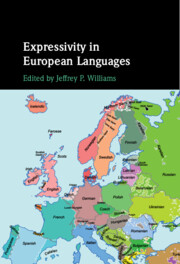Book contents
- Expressivity in European Languages
- Expressivity in European Languages
- Copyright page
- Contents
- Figures
- Tables
- Contributors
- 1 Introduction
- Uralic
- Germanic
- Hellenic
- Romance
- 7 Repetition and reduplication in Italian
- 8 Analysing expressives in a spoken corpus of Majorcan Catalan
- Celtic
- Vasconian
- Caucasian
- Comparative
- Index
- References
8 - Analysing expressives in a spoken corpus of Majorcan Catalan
from Romance
Published online by Cambridge University Press: 24 August 2023
- Expressivity in European Languages
- Expressivity in European Languages
- Copyright page
- Contents
- Figures
- Tables
- Contributors
- 1 Introduction
- Uralic
- Germanic
- Hellenic
- Romance
- 7 Repetition and reduplication in Italian
- 8 Analysing expressives in a spoken corpus of Majorcan Catalan
- Celtic
- Vasconian
- Caucasian
- Comparative
- Index
- References
Summary
The chapter analyses a small corpus of twelve Catalan folk tales voice-dramatised and radio broadcast in Majorca in 1959. Most of the lexical material studied here is elicited from the same source and from Diccionari Català-Valencià-Balear, a master work of 20th-century romance lexicography. The expressive resources used in the recordings can be analysed as actual resources in the language for they are shared by both speakers and listeners and they successfully convey a part of the meaning. Along with voice-attached resources as pitch, intensity, or speech rate, other more conventional means such as those preserved in writing (morphological, lexical, syntactic) are also analysed. The findings by Dingemanse and Akita (2017) on the (inverse) relation between expressiveness and grammatical integration are used. The chapter demonstrates the degree to which expressives can be marked by means of phonetic cues in Catalan, initially setting the border between ideophones and unconventional spoken iconicity. By comparing oral and written versions of the same tales it is proposed that fixability by writing is a good test of grammatical integration, at least a necessary condition.
Information
- Type
- Chapter
- Information
- Expressivity in European Languages , pp. 269 - 292Publisher: Cambridge University PressPrint publication year: 2023
References
Accessibility standard: Unknown
Why this information is here
This section outlines the accessibility features of this content - including support for screen readers, full keyboard navigation and high-contrast display options. This may not be relevant for you.Accessibility Information
- 1
- Cited by
